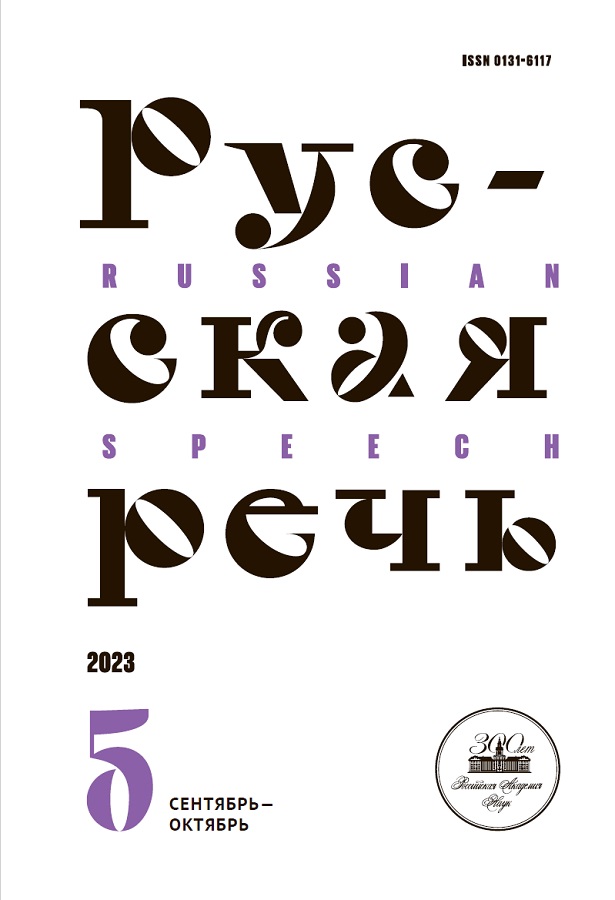Kstati (For Good Measure), Which is Not always a Good Measure: the Specifics of the Use of the Unit in Modern Oral Everyday Speech
- 作者: Prokopenko A.A.1
-
隶属关系:
- Saint Petersburg State University
- 期: 编号 5 (2023)
- 页面: 32-44
- 栏目: Articles
- URL: https://rjmseer.com/0131-6117/article/view/652347
- DOI: https://doi.org/10.31857/S013161170028365-0
- ID: 652347
详细
The word kstati (by the way, for good measure) actively functions in oral everyday speech and can be perceived by listeners as a junk word. However, such use of this unit remains outside the scope of its lexicographic description. This article examines the semantic, functional and structural features of the word kstati on the material of speech corpora, as well as the author's notes of the spoken speech. Thus, in spoken speech kstati expresses subjective-modal meanings of ‘accentuation of the listener's attention’ and ‘inconsistency with the expected’. The main function of this word is connective. It can connect closely and distantly located replicas, as well as extralinguistic information and the speaker's utterance. In addition to the connective function, kstati can return the interlocutor's attention to what was previously said or introduce a new topic of conversation. The following uses of this unit seem inappropriate: 1) if the connection of the components of the utterance is clear only to the speaker, 2) in the meaning of ‘inconsistency with the expected’. In addition, the article describes the communicatives kstati, kstati da / da kstati, as well as such constructions as
参考
- Ахманова О. С. Словарь лингвистических терминов. М.: Советская энциклопедия, 1966. 608 с.
- Баранов А. Н., Добровольский Д. О. Кстати и некстати: к речевым практикам Достоевского // Русский язык в научном освещении. 2018. № 1 (35). С. 33–45.
- Богданова Н. В. О проекте словаря дискурсивных единиц русской речи (на корпусном материале) // Компьютерная лингвистика и интеллектуальные технологии: по материалам ежегодной Международной конференции «Диалог» (Бекасово, 30 мая – 3 июня 2012 г.). Вып. 11 (18), т. 1. М.: РГГУ, 2012. С. 71–80.
- Богданова-Бегларян Н. В. Прагматемы в устной повседневной речи: определение понятия и общая типология // Вестник Пермского университета. Российская и зарубежная филология. 2014. Вып. 3 (27). С. 7–20.
- Богданова-Бегларян Н. В. Ядро и периферия лексико-грамматической характеристики русского слова: о судьбе периферийных единиц // Мир русского слова. 2020. № 2. С. 23–31.
- Богданова-Бегларян Н. В., Маслова Е. Р. Русские контактные глаголы в устной спонтанной речи: объем словника и функционально-семантическое разнообразие // Acta Linguistica Petropolitana. Труды Института лингвистических исследований РАН / Гл. ред. Е. В. Головко. Том XV, часть 3. I. Актуальные проблемы изучения русского глагола / Ред. М. Д. Воейкова, С. В. Краснощекова, Е. Г. Сосновцева; II. Varia. СПб.: ИЛИ РАН, 2019. С. 158–184.
- Жукова С. Ю. Дискурсивные формулы русского языка в диахроническом аспекте (на материале XVIII–XXI веков): дис. … канд. филол. наук. М., 2021. 283 с. (машинопись).
- Левонтина И. Б. Похоже ли походу на похоже? // Русская речь. 2020. № 6. С. 28–39.
- Откидыч Е. В. Особенности присоединения правого контекста с помощью скрепы-фразы КСТАТИ, О + N6 // Филологические науки. Вопросы теории и практики. 2015. № 12-3 (54). С. 145–148.
- Откидыч Е. В. Функционирование текстовых скреп кстати и между прочим в монологическом и диалогическом тексте: автореф. дис. … канд. филол. наук. Томск, 2017. 20 с.
- Попова Т. И. «Эхо»-реакция в диалоге: корпусное исследование устного дискурса в гендерном аспекте // LI Международная научная филологическая конференция имени Людмилы Алексеевны Вербицкой. 14–21 марта 2023, С.-Петербург. Сб. тезисов. СПб.: Изд-во СПбГУ, 2023. С. 1003–1004.
- Приемышева М. Н. Разговорная лексика vs разговорная речь: тенденции и проблемы лексикографического описания // Повседневная речь как объект лексикографии (Тринадцатые Шмелевские чтения). Тезисы докладов международной конференции (23–25 февраля 2020 г.). М.: Институт русского языка им. В. В. Виноградова РАН, 2020. С. 58–60.
- Рахилина Е. В., Кузнецова Ю. Л. Лингвистика конструкций / Отв. ред. Е. В. Рахилина. М.: Изд. центр «Азбуковник», 2010. 584 с.
- Русская грамматика. Т. II. / Гл. ред. Н. Ю. Шведова. М.: Наука, 1980. 709 с.
- Шаронов И. А. Коммуникативы и методы их описания // Компьютерная лингвистика и интеллектуальные технологии: по материалам ежегодной Международной конференции «Диалог». М.: РГГУ, 2009. С. 543–547.
- Fillmore Ch. J., Kay P., O’Connor M. C. Regularity and Idiomaticity in Grammatical Constructions: The Case of Let Alone // Language, 1988, vol. 64, no. 3, pp. 501–538.









